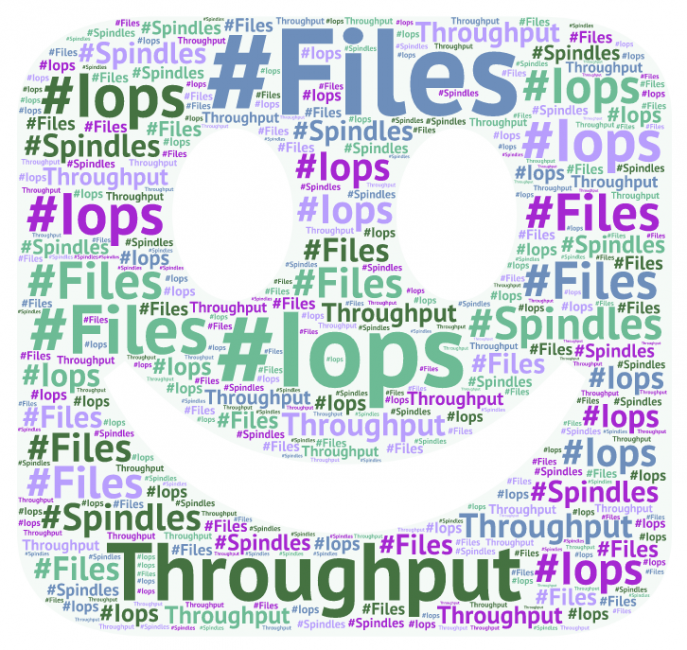Approvals: 0/1
<HTML> <!— — title: “Parallel I/O” date: December 5-6, 2017 keywords: - high performance computing - I/O header-includes: - <meta name=“duration” content=“10” /> — —> </HTML>
Reason for I/O
Input and output of calculations: always as file
* Size of I/O may vary: at least a flag, but maybe large data sets * Intermediate files * Checkpoints
VSC infrastructure
* No monitor * No printer
Organizational
Questions: immediately
Coffee: immediately
Comments/Feedback: yes, please!
Limiting factors to high performance
- CPU performance
- Integer
- Floating point
- Scheduler
- Caches
- Memory performance <html><!— * Number of memory banks
- ECC (Error correcting code)—></html>
- Network performance
- Locality
- (Partially) shared ressource
- Storage
- shared ressource
- I/O throughput
- IOPS: Input/Output Operations per Second
High Performance Computing
CPU: 10^10 operations per second
Memory: 10^8 operations per second
Network: 10^6 operations per second
SSD: 10^5 operations per second
HDD: 10^2 operations per second
High Performance Storage
High performance: throughput and IOPS
- Throughput
- Each node is limited by network bandwidth
- Each storage server is limited by network bandwidth
- Many nodes ⇒ high throughput
- IOPS
- Network latency
- Block devices
- HDD (Hard Disk Drive) latency
- Seek time
- Rotational latency
- SDD (Solid State Drive) latency
- Fetch time for a block
High Performance Storage
Latency should not dominate
Combine I/O operations
Methods
- Buffering
- Avoid many small files
- Combine data in few large files
- Parallel I/O
Topics of today
- Introduction to I/O (this talk)
- Storage technologies
- VSC storage infrastructure
- Application view to I/O
- Performance hints and best practices for I/O
- MPI I/O (overview)
Tomorrow: Parallel I/O and Portable Data Formats
- NetCDF4: Network Common Data Form
- PnetCDF: Parallel NetCDF
- HDF5: Hierarchical Data Format
Introduction to I/O
- Concepts
- Technology names
- Management view
User view to I/O
User view to I/O
- Storage~size
- File~size
- Highly~available
- Temporary
- Backup
- Shareable:
- Available in web browser worldwide?
- Mounted on your desktop?
- Visibility:
- User, Group, All Users (=‘Other’)
- Access control lists (ACLs)
Performance
<html><img src=“pictures/Performance_wc.png” alt=“user view” style=“position: static; vertical-align: center”/></html>
Performance
Usage
<html><img src=“pictures/Usage_wc.png” alt=“user view” style=“position: static; vertical-align: center”/></html>
Usage
- sequential~access
- random~access
- write~once
- append
- modify
- flush
- locking (Deadlocks!)
- byte range locking (Deadlocks!)
- read~once
- read~often
- read~never (e.g. log files, snapshots)
Security/Safety
<html><img src=“pictures/Secure_wc.png” alt=“user view” style=“position: static; vertical-align: center”/></html>
Security/Safety
- Redundancy
- RAID: Redundant Array of Independent Disks
- RAID levels (0,1,5,6)
- Erasure~coding
- How many copies
- software~RAID
- Repair~times
- Buffer~Battery - supercapacitor
- USV~UPS: Unterbrechungsfreie Stromversorgung - Uninterruptible Power Supply
- Reliability: disk failures
Technology
<html><img src=“pictures/Technology_wc.png” alt=“user view” style=“position: static; vertical-align: center”/></html>
Technology
<HTML> <!— {height=200px style=“float: right;”}—> </HTML>
- HDFS: Hadoop Distributed File System
- DAS: Direct Attached Storage (JBOD: Just a Bunch of Disks)
- SAN: Storage Area Network
- NAS: Network Attached Storage
- Block~storage
- Disk~partitions
- LVM: Logical Volume Manager
- Physical Volume (PV)
- Volume Group (VG)
- Logical Volume (LV)
- Journaling File Sytems: XFS - ZFS - Ext4 - BtrFS
- NFS - SMB (CIFS)
- Inode
- SCSI, SAS, SATA, NVMe, FC, iSCSI, SRP
- 3.5“, 2.5” form factor
- SSD: wear leveling
- I/O scheduler
- Object storage
- Tiered storage
- Tape storage
Technology used by VSC
- NAS: Network Attached Storage
- Block~storage
- Disk~partitions
- LVM: Logical Volume Manager
- Physical Volume (PV)
- Volume Group (VG)
- Logical Volume (LV)
- Journaling File Sytems: XFS - ZFS - Ext4
- NFS
- Inode
- SAS, NVMe
- 3.5“, 2.5” form factor
User - Performance
User - Performance
Storage size - parallel file system - number of spindles - throughput
Temporary - locality - IOPS
Highly available - throughput
File size - number of files - storage size
User - Usage
User - Usage
Performance - Usage
Performance - Usage
User - Security/Safety
User - Security/Safety
Storage size - redundancy
Highly available - RAID - erasure coding
Backup - redundancy
Highly available - USC - UPS
Highly available - buffer battery
User - Technology
User - Technology
Storage size - DAS - NAS - SAN
Highly available - HDFS
Visibility - object storage
Storage size - tiered storage
Big Data
Technology available
- Large disks
- Fast computers
- Lots of data
The result is called ‘Big Data’
Data growth
New data is generated digitally
Data creation increases exponentially
Internet / Social networks / Mobile Devices
Internet of Things
- Sensors everywhere create data
- Growing exceptionally fast
Medicine / Genome
Science
Types of data
- Databases
- Text
- Video
- Image
- Sensor data
V3
Characterization of Big Data by
- Volume
- Velocity
- Variety
Tools
- NoSQL
- Object Storage
- HDFS
- Cheap building blocks
- Replication
- Hadoop
- Requirement: linear scaling
- Cloud computing
Hadoop software tools
- Yarn: framework for job scheduling
- MapReduce: parallel processing, very well scaling
- HBase: distributed database
- Hive: data warehouse infrastructure with ad-hoc-querying
- Pig: high-level data-flow language
- Cassandra: distributed database
- Flume: aggregate and move large amounts of data
- Kafka: distributed streaming
- Spark: compute engine for hadoop data, more flexible than MapReduce
- …
Applications
- Advertising / Sales
- Problem analysis
- Microtrends
- Genomics
- Archaeology
- Science
- …















